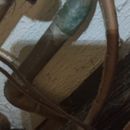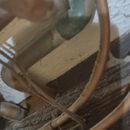Worth swapping copper for pex?
I’m remodeling the basement and with that comes a new shower. Some of these copper pipes look a little sketchy/greenish. Mind you some are just for baseboard heat… Would changing the existing shower pipes from copper to PEX be worth my time/money here??
GBA Detail Library
A collection of one thousand construction details organized by climate and house part












Replies
Cooper turns green naturally just polish/clean it before soldering the joints. You will want to address the moisture problem causing that reaction. Could be as simple as air sealing around the rim joist. Pretty common for basement remodels.
Nope, you gain nothing swapping that out -- there's nothing wrong with those copper pipes. The greenish spot around the solder joints is because the acidic flux corrodes the copper if it's not cleaned off at install time. That's not a problem, since it's just some surface corrosion which is the greeness you're seeing. You can usually clean that off with a scouring pad or some light sandpaper if you want to clean up the appearance.
I would check to be sure none of the solder joints are leaking though, especially 90s on hot water lines. If you find any leaks, just heat the joints up to reflow the solder and you'll seal things back up. That one 90 that is going up into a wall, that one I'd check a little since it looks like there might be a leak from somewhere further up in the wall that has been running down and dripping off the lower 90. It shouldn't be hard to fix once found though if there is a leak.
I'd change things so that the soft copper tubing making that big swept bend in your last pic isn't touching the rigid copper pipe. If it's too tight, I'd put a piece of EPDM between the two pipes. The reason for this is that heat/cool cycles can make those pipes bang, and over time that can wear the pipes. That's probably not much of an issue for water lines, but in refrigeration systems I've seen lines get completely worn through at clamps sometimes. A rubber pad as a buffer will keep things under control.
Bill
Not quite as simple as "If you find any leaks, just heat the joints up to reflow the solder and you'll seal things back up." You cannot solder a pipe that contains water. Maybe in the rare case you'll get lucky reheating a leaky joint (after draining the water out of the pipe first), but the majority of plumbers I've worked with say the only truly effective way to deal with a leaking joint is to disassemble it, clean pipe and fitting, flux, and resolder.
That is my experience as well. And often the reason the joint was poorly done in the first place is that it's a spot that's either hard to get at or hard to get the water out of. In that case the only solution is to cut the pipe back to a spot that's easy to work on, make a big enough hole to get the pipe and fitting out together, resolder them on a bench, put the assembly back in and then solder where you cut.
But my water has a high enough mineral content that tiny leaks will seal themselves over time as the minerals precipitate out. So something like that I'd just leave be.
OK, yes, I left out the "drain the pipe" step. I've probably done this enough times that I don't even think about that part anymore. Reflowing the solder AFTER you drain the pipe DOES fix the leak, but that does assume that the leak is due to cracked solder. I have found this to be the case with 90 degree fittings, especially when doubled up so that the thermal expansion/contraction of the pipe results in the 90's seeing a twisting motion of the pipe and not just a bending motion.
If the joint was bad to begin with, such as a poorly prepped or fluxed assembly prior to the original solder being applied, then you probably don't have a good solder joint and reflowing won't cause the solder to wick into any crusty areas inside. In this case you need to dissassemble the joint, clean it, flux it, reassemble, and then resolder.
I have always taken the time to clean the pipe end and inside of the fitting with a wire brush and/or emery cloth and/or a scotchbrite pad as a first step. This assumes you've already cut the pipe cleanly and deburred the cut end. The goal is to make a bright and shiny copper surface on both "sides" of the mating joint as a prep step. I then apply flux to both "sides" of the joint, assemble (ideally with a slight twist if possible as I slide things together), I then heat the joint, moving the torch to preheat the pipe and fitting, and let solder wick into the joint from the top until it just flows out a tiny bit from the bottom. The actually solder wetting step should only take a few seconds.
I prefer the water clean flux, but I've found that type of flux to be much less forgiving than the older style stuff. If you're doing a DIY job and don't have a lot of experience, I'd use the old school flux since it's harder to burn off with the torch. If you have some skill, I'd use the water clean flux since it's much easier to clean, but it's also much easier to burn off, and once burned, the carbonized remains will prevent solder from flowing.
BTW, DC, I find my well water self-seals very slow leaks in plumbing unions over a day or two. The minerals plate out in the tiny gaps and seal them over time. If you have hard water, that does work as long as the leak is only a very, very slow ocassional drip.
Bill